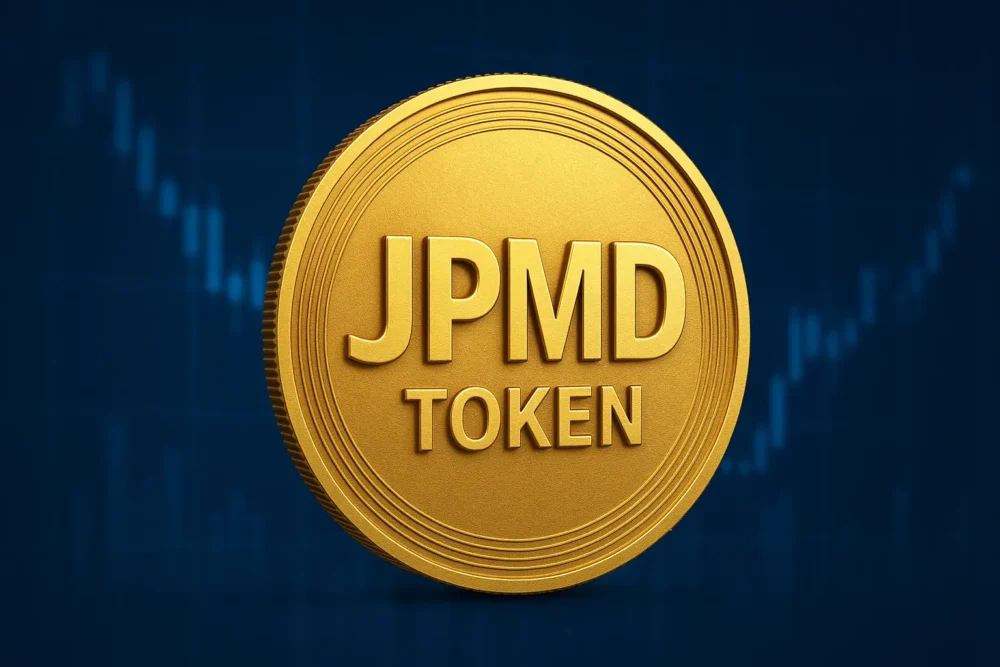JPMorgan Chase has taken a decisive step into the future of finance with the official launch of its digital token, JPMD.
Designed as a tokenised form of commercial bank deposits, JPMD is a clear indication that one of the world’s most established financial institutions is embracing blockchain technology with serious intent.
The JPMD token will operate on Base, a public blockchain developed by Coinbase and built on the Ethereum network.
This move signifies JPMorgan’s ambition to merge traditional banking mechanisms with emerging digital financial infrastructure.
Although JPMD may appear similar to stablecoins, JPMorgan has emphasised that the token is distinct in several key ways. Stablecoins are typically pegged to fiat currencies and are accessible to a wide range of users.
In contrast, JPMD is a “permissioned token” available only to institutional clients. This exclusivity aligns the token with traditional compliance protocols, while offering the advantages of blockchain settlement.
The global co-head of Kinexys, JPMorgan’s blockchain unit, Naveen Mallela, described JPMD as a transformative tool. “Institutions are looking for efficient and reliable on-chain cash solutions, and JPMD is designed to meet that demand”, he said.
Mallela explained that JPMD supports cross-border business transactions and streamlines on-chain settlements.
In a notable departure from JPMorgan’s previous scepticism about cryptocurrency, the bank now seems committed to shaping its future. “With JPMD, we are not just entering the crypto space; we are redefining how digital assets can coexist with traditional finance”, Mallela stated.
JPMorgan’s launch follows its recent trademark filing for JPMD, further solidifying its commitment to creating digital financial services.
As a result of this initiative, JPMorgan will offer token-based banking to pre-approved institutional clients on Base, a leading Ethereum Layer 2 network supported by Coinbase Global Inc.
JPMD’s strategic features and pilot testing
At the core of JPMD’s appeal are several high-impact features designed to address the needs of institutional finance.
Firstly, the token supports 24/7 settlements, enabling financial transactions outside conventional banking hours. This round-the-clock capability boosts liquidity and speeds up operations for users.
Secondly, JPMD has the potential to offer interest to token holders. This interest-bearing quality sets it apart from most stablecoins, which typically do not yield returns. It also helps align the product more closely with traditional deposit accounts.
Thirdly, the permissioned nature of JPMD provides a layer of enhanced security. By restricting access to authorised institutional clients only, JPMorgan ensures that the token operates within a tightly controlled environment – ideal for regulatory oversight and compliance.
The pilot phase for JPMD is already underway. Mallela confirmed to Bloomberg that JPMorgan would soon transfer a fixed number of tokens to Coinbase.
The transactions will be denominated in US dollars, though additional currencies could be supported pending regulatory approval.
Once testing concludes in the coming months, institutional users on Coinbase will be able to access JPMD for digital transactions.
According to Mallela, deposit tokens like JPMD offer scalability advantages due to their backing through fractional reserves.
“From an institutional standpoint, deposit tokens are a superior alternative to stablecoins”, he said. He also suggested that the yield-bearing potential of JPMD could outpace existing stablecoin offerings over time.
Initial responses from the market have been favourable. Large institutional clients are reportedly interested in using JPMD as a stable and compliant means of digital transaction.
The collaboration with Coinbase adds to the credibility and reach of this initiative, especially considering Base’s rising prominence in the Ethereum Layer 2 ecosystem.
Currently, Base holds around $3.7 billion in total value locked and a stablecoin market capitalisation of approximately $4.13 billion.
Regulation, market context, and the GENIUS Act
The introduction of JPMD comes at a crucial moment for the digital asset landscape. The stablecoin market is undergoing major transformation, with global regulations gaining momentum.
At present, stablecoins like $USDT (Tether) and $USDC (Circle) dominate the $262 billion market. These tokens operate largely outside traditional banking channels and have faced varying degrees of regulatory scrutiny.
JPMorgan’s approach seeks to solve this problem by aligning its digital token with the principles of regulated banking. The timing of JPMD’s release is especially relevant, as the US Senate has just passed the GENIUS Act – a major bill aimed at establishing a regulatory framework for stablecoins.
Senator Kirsten Gillibrand, one of the bill’s sponsors, stated: “The GENIUS Act will protect consumers, enable responsible innovation, and safeguard the dominance of the US dollar”.
With a 68-30 vote in the Senate, the bill now moves to the House of Representatives, where it is expected to pass given similar political alignment.
Introduced by Senator Bill Hagerty earlier this year, the GENIUS Act aims to regulate stablecoins backed by fiat currencies. Hagerty called it an “inflection point” for digital finance, saying the legislation would improve payment efficiency and reinforce the global dominance of the dollar.
Treasury Secretary Scott Bessent has echoed this sentiment. He remarked that such stablecoins could grow the current $261 billion market to $3.7 trillion by 2030. He also emphasised their role in lowering government borrowing costs by driving demand for US Treasuries.
The GENIUS Act mandates that stablecoins be fully backed, issuers undergo regular audits, and operations be cleared by federal or state authorities.
The legislation also limits the issuance of algorithmic stablecoins and opens up opportunities for banks, tech firms, and retailers to create their own compliant digital currencies.
Meanwhile, the European Union and the United Kingdom are also advancing regulatory frameworks for stablecoins, further underlining the global shift toward formalising the sector.
In parallel, blockchain intelligence platform TRM Labs has released data suggesting that over 60% of crypto transaction volume in 2024 was conducted using dollar-pegged stablecoins.
Moreover, 99% of all stablecoin activity was found to be legal and compliant with existing regulations. However, TRM also highlighted that stablecoins accounted for 60% of illicit crypto transaction volume in Q1 2025, underlining the need for comprehensive oversight.
“TRM data shows that stablecoins have become a core feature of digital asset markets – not just for trading, but for payments, remittances, and savings as well”, the platform noted in its recent blog.
Still, there are concerns within the traditional banking sector. Some insiders fear that the rise of yield-bearing stablecoins could disrupt conventional financial models.
According to NYU professor Austin Campbell, some banking executives are worried that these developments could “harm” their traditional interests.
Nonetheless, the clear movement toward regulation, alongside JPMorgan’s strategic positioning with JPMD, suggests that the sector is heading towards a new, compliant, and scalable phase of development.
As Mallela noted, the objective is not merely to take part in the cryptocurrency movement. JPMorgan aims to redefine how digital and traditional finance can work in tandem – a vision that could shape the financial landscape for years to come.


